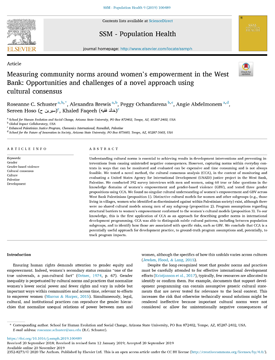As the West Bank’s justice sector becomes more transparent, citizens are becoming more engaged, recognizing their government’s improved efficiency and accountability.

Measuring Community Norms Around Women’s Empowerment in the West Bank: Opportunities and Challenges of a Novel Approach Using Cultural Consensus .
Paper | December 31, 2019

Understanding cultural norms is essential to achieving development results but can sometimes be difficult. The authors of this paper tested a novel method to monitor and evaluate a USAID justice project in the West Bank, Palestine.
Understanding cultural norms is essential to achieving results in development interventions and preventing interventions from causing unintended negative consequences. However, capturing norms within everyday contexts in ways that can be monitored and evaluated can be expensive and time consuming and is not always feasible. We tested a novel method, the cultural consensus analysis (CCA), in the context of monitoring and evaluating a USAID justice project in the West Bank, Palestine.
We conducted 392 survey interviews with men and women, using 60 true or false questions in the knowledge domains of women’s empowerment and gender-based violence (GBV), and tested three gender propositions using CCA. We found no singular cultural understanding of women’s empowerment and GBV across West Bank Palestinians (proposition 1). Distinctive cultural models for women and other subgroups (e.g., those living in villages, women who identified as discriminated against within Palestinian society) exist, although there were no shared cultural models among men of any subgroup (proposition 2). Program assumptions regarding structural barriers to women’s empowerment conformed to the women’s cultural models (proposition 3).
To our knowledge, this is the first application of CCA as an approach for describing gender norms in international development programming. CCA was able to distinguish subtle cultural patterns, including between population subgroups, and to identify how those are associated with specific risks, such as GBV. We conclude that CCA is a potentially useful approach for development practice, to ground-truth program assumptions and, potentially, to track program impacts.
